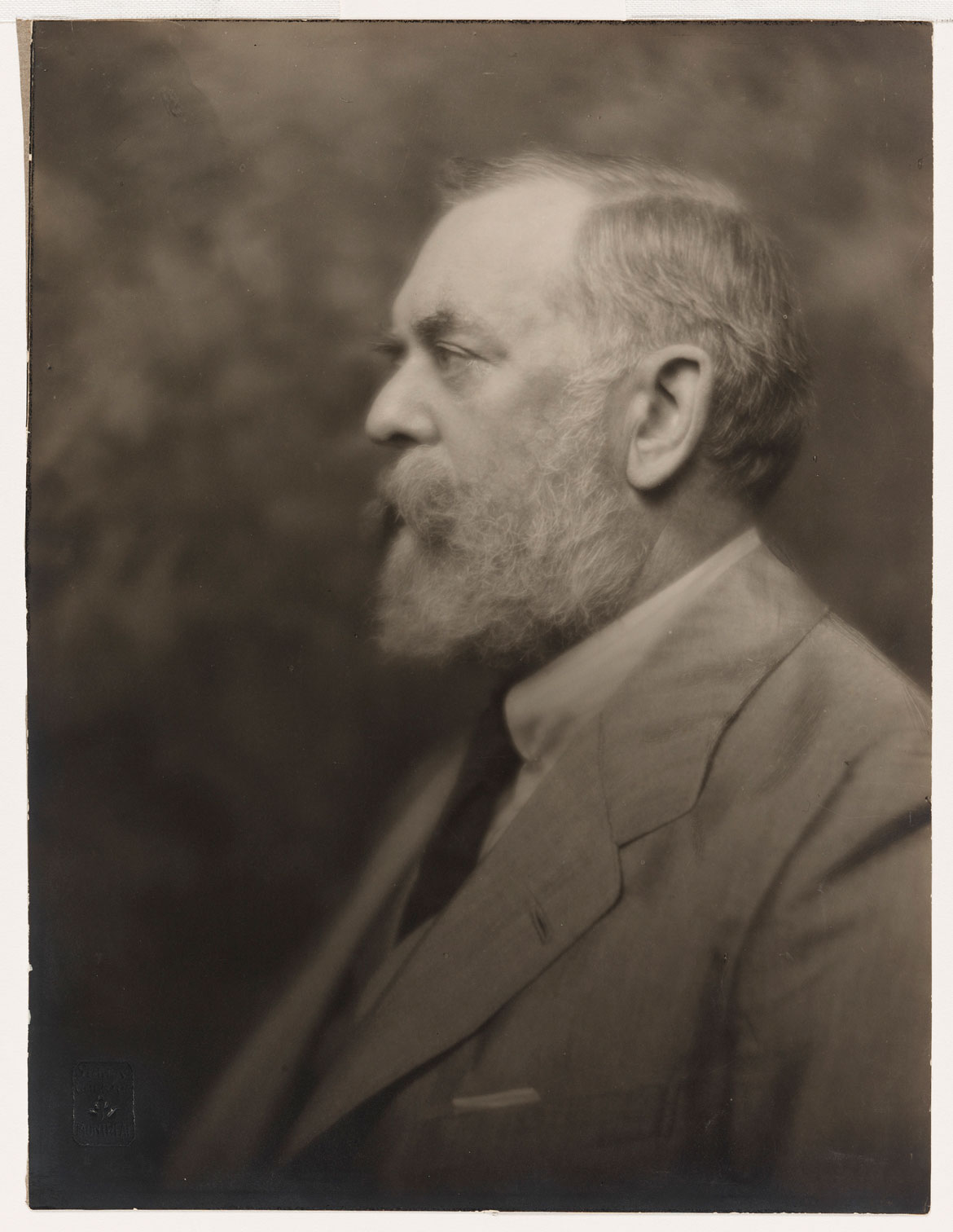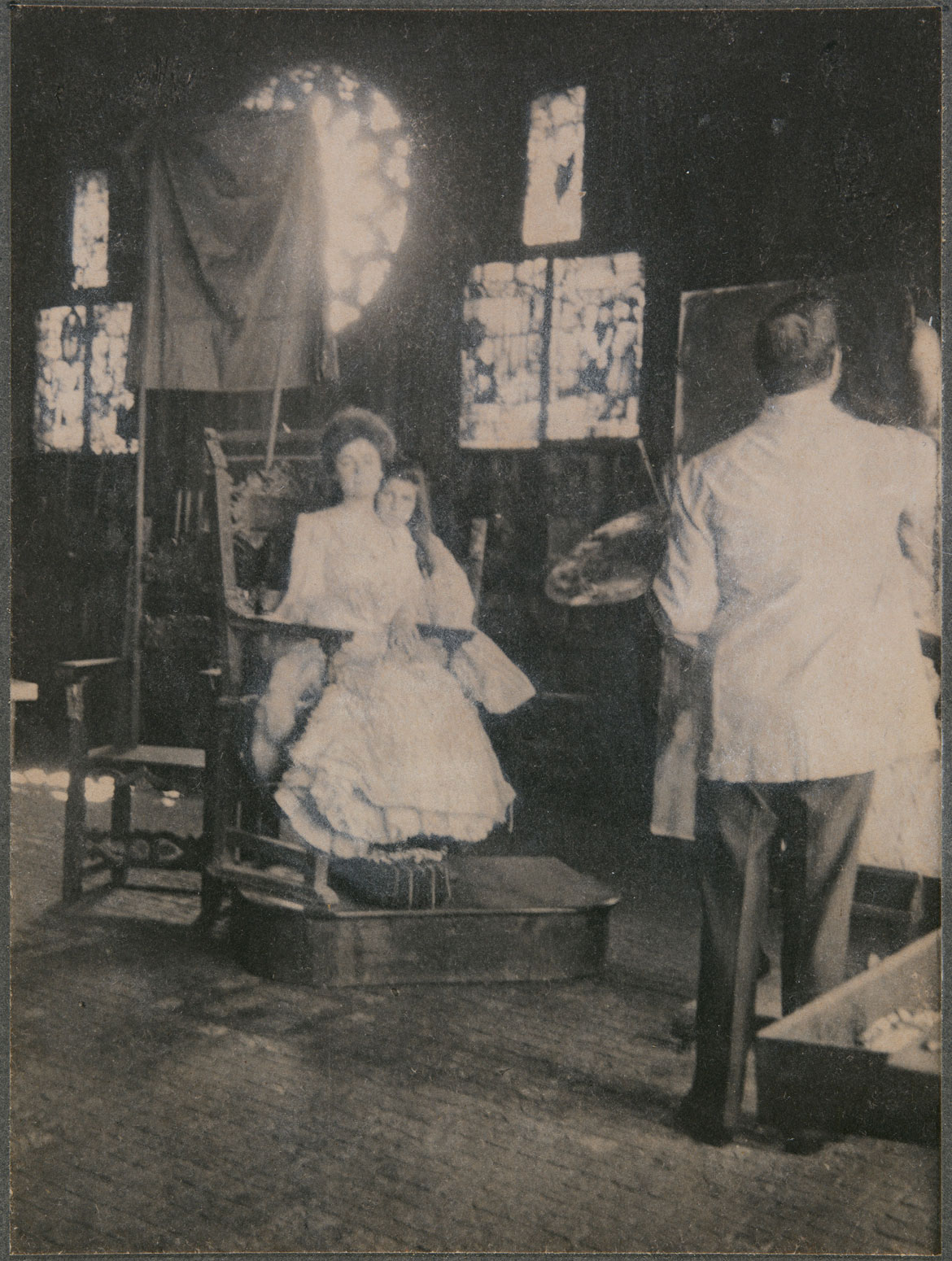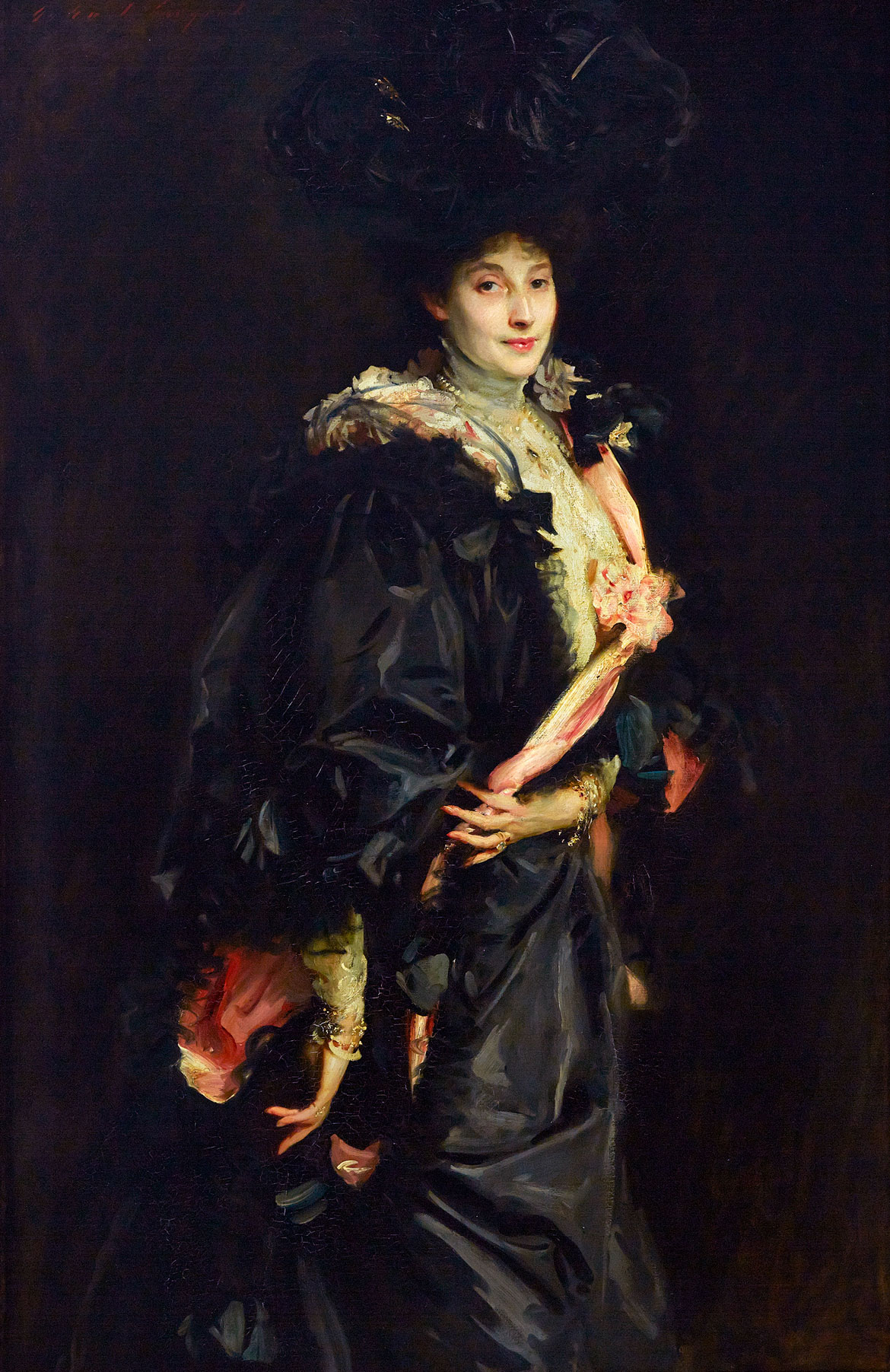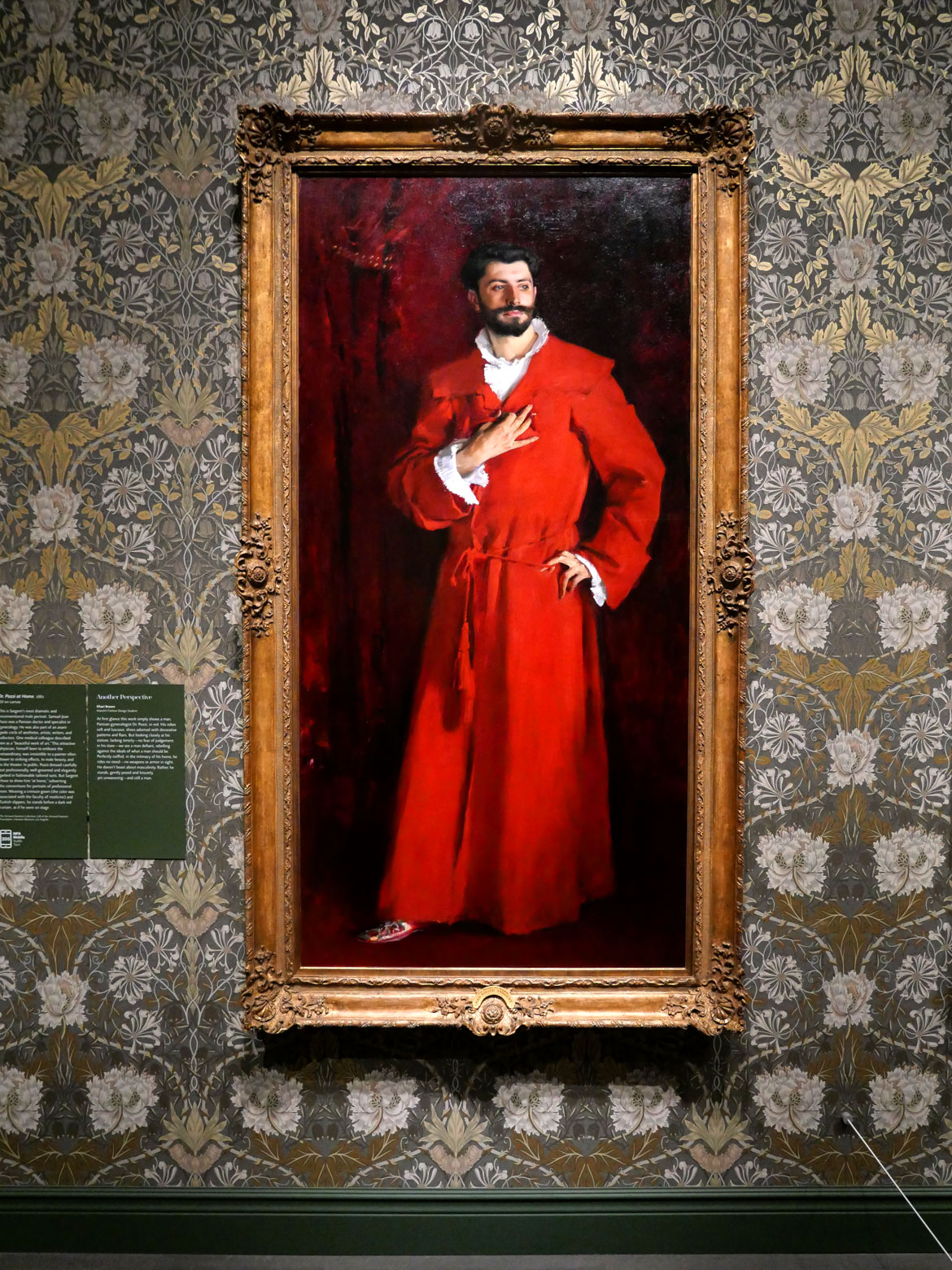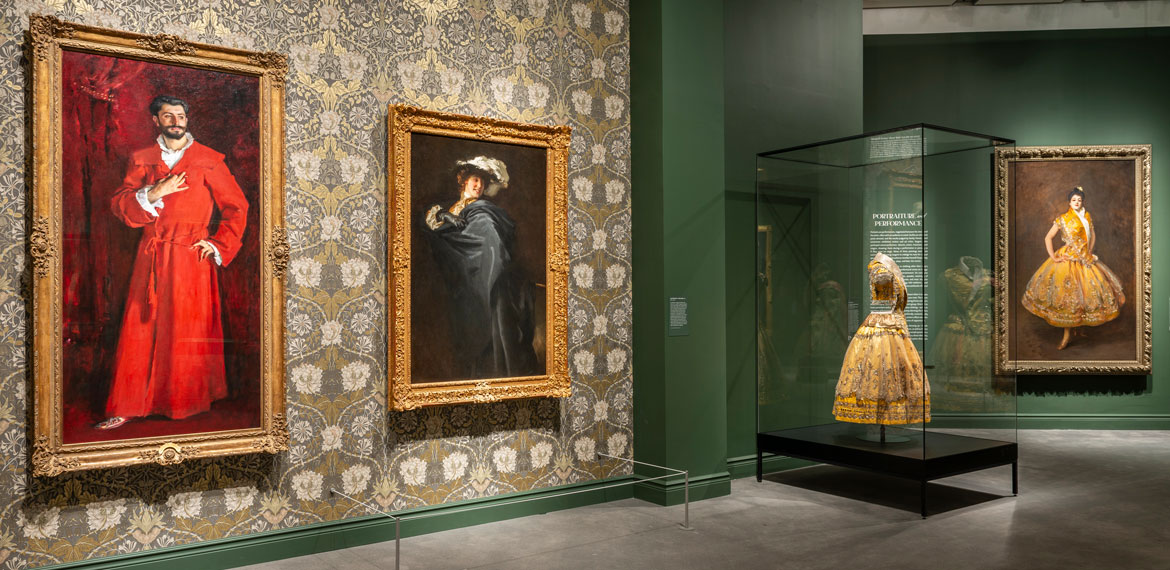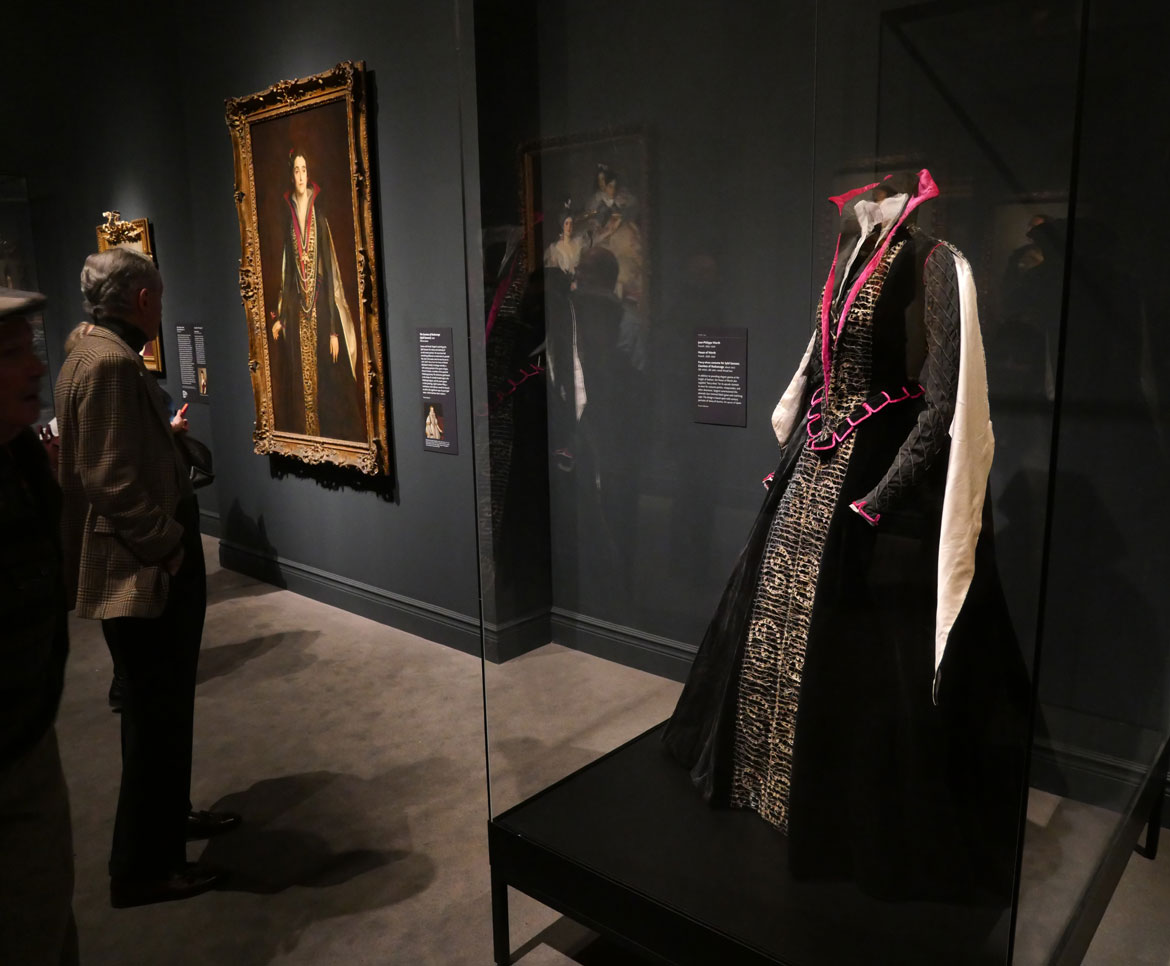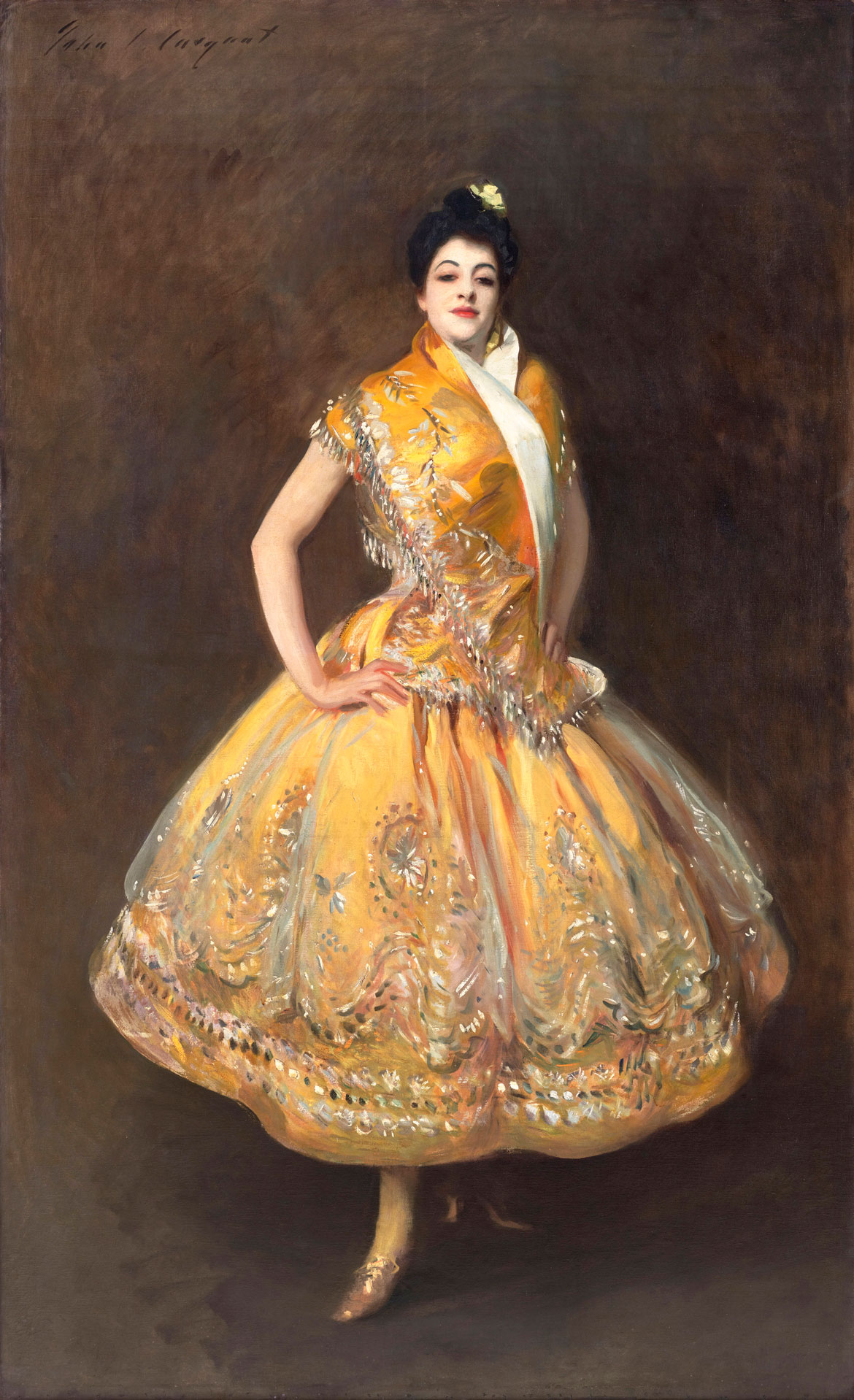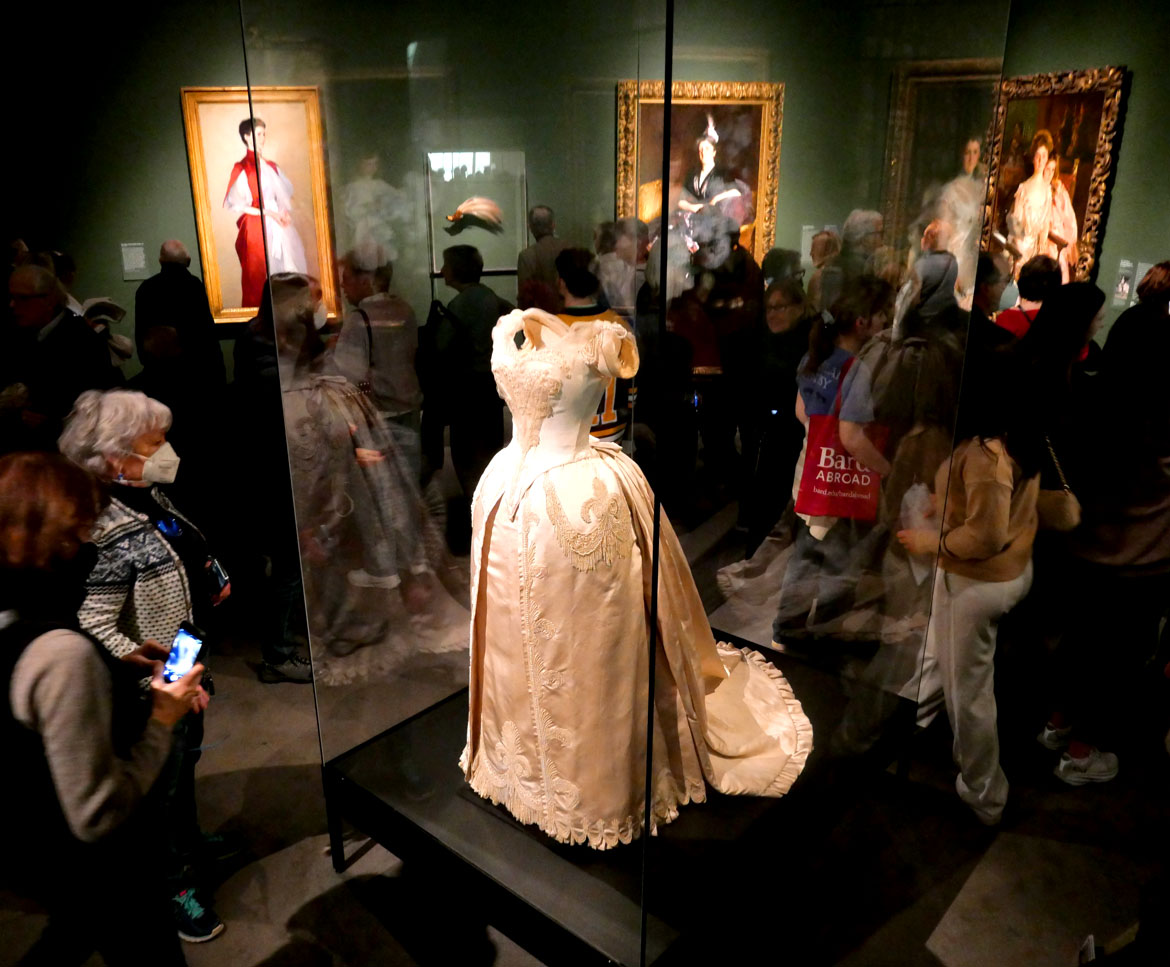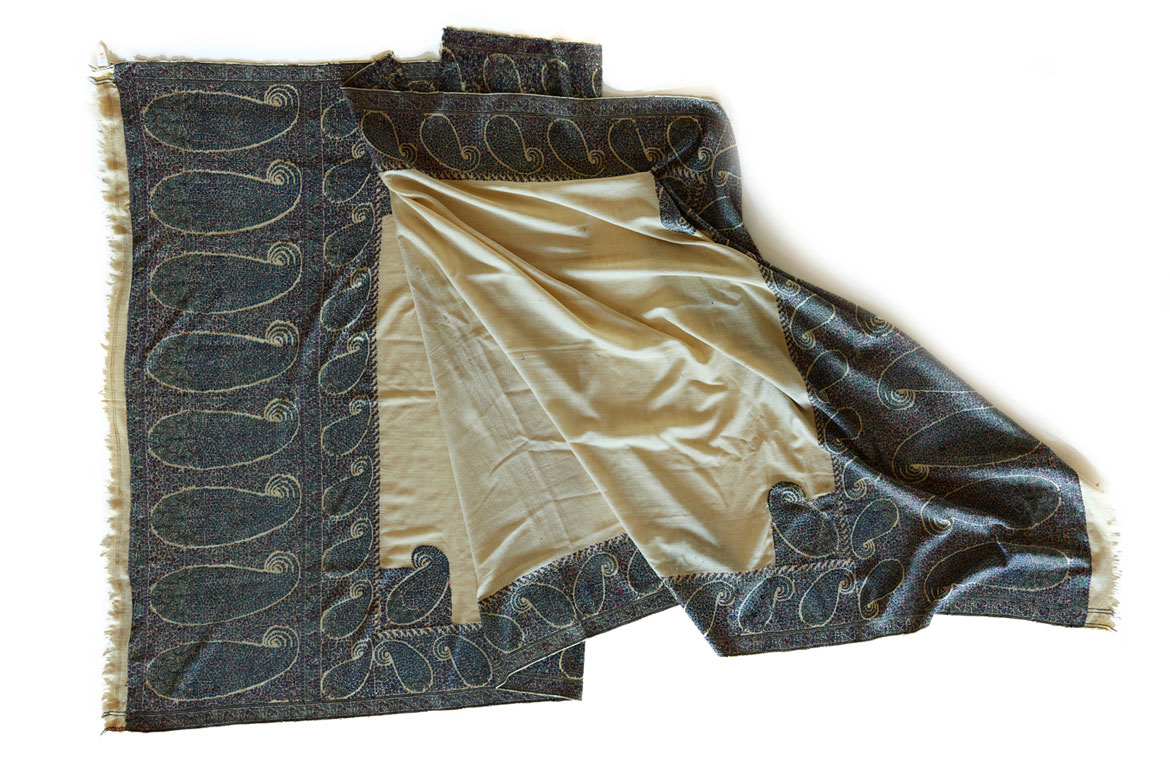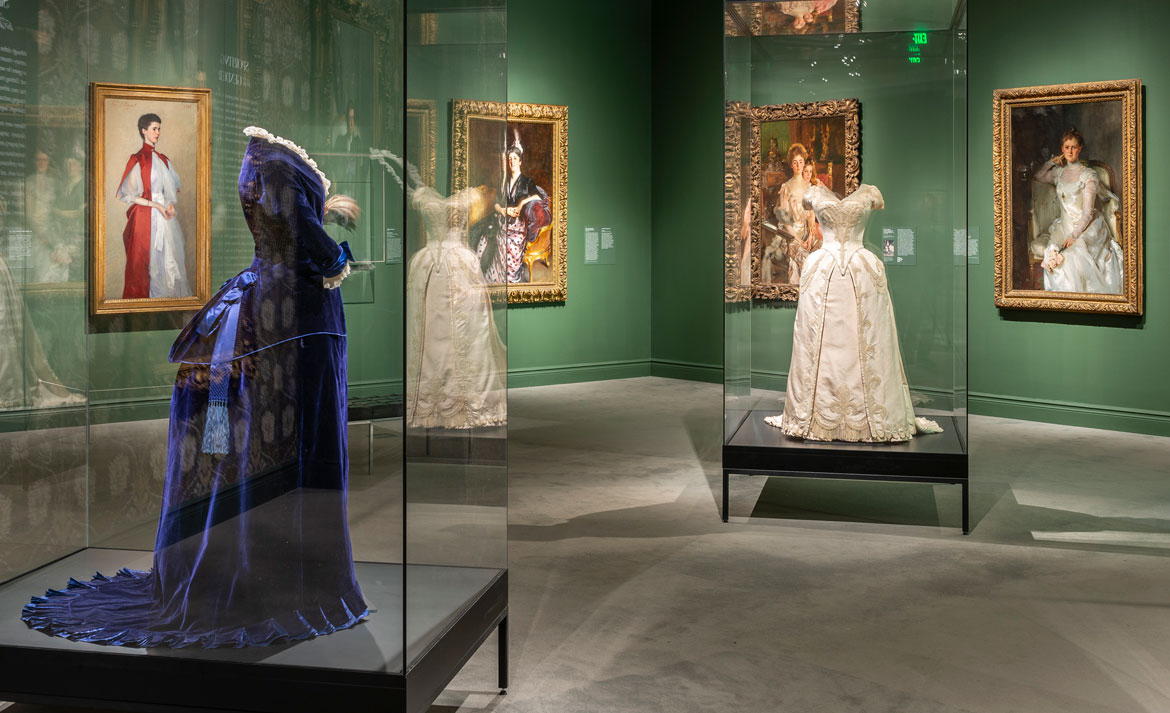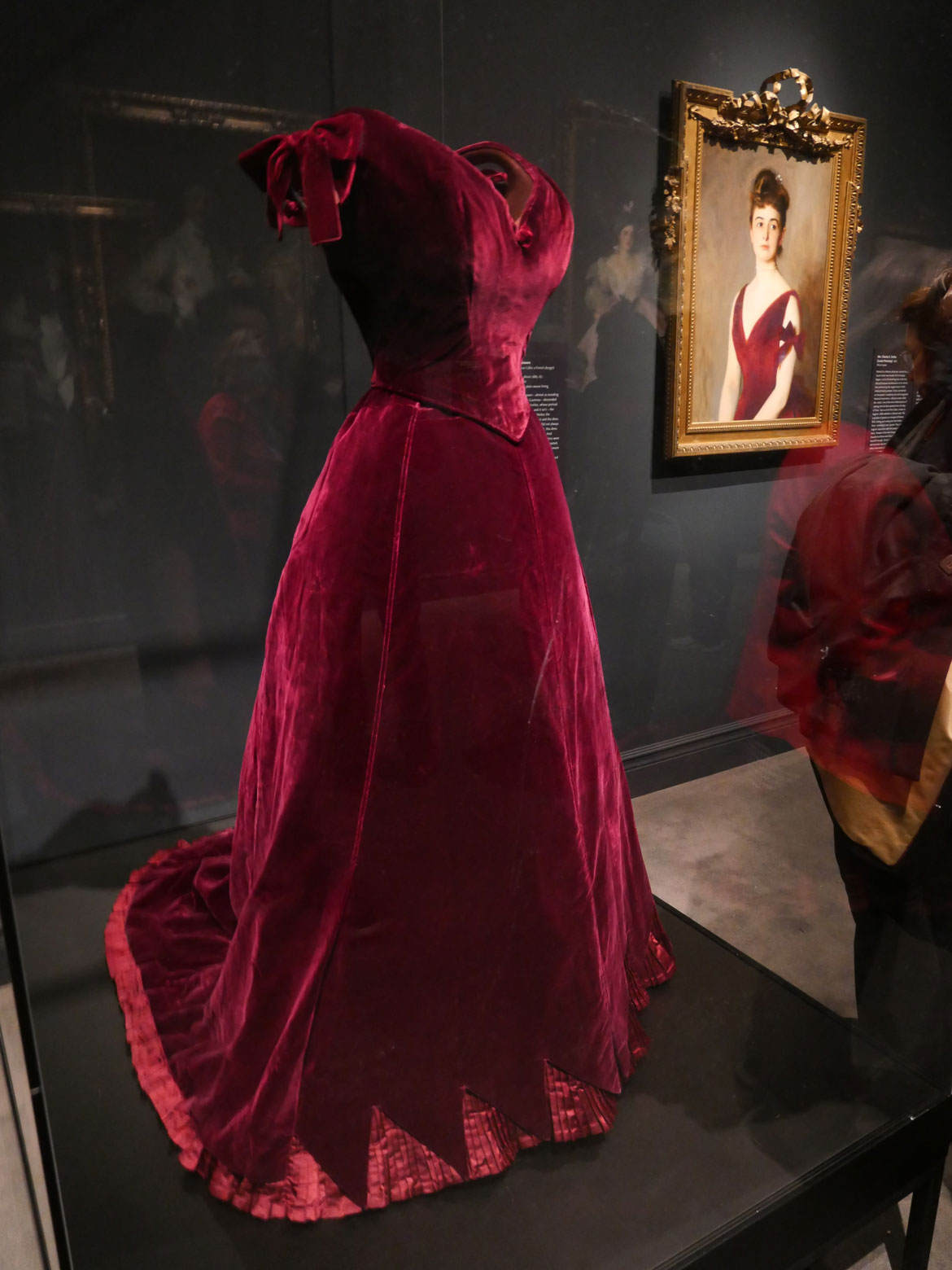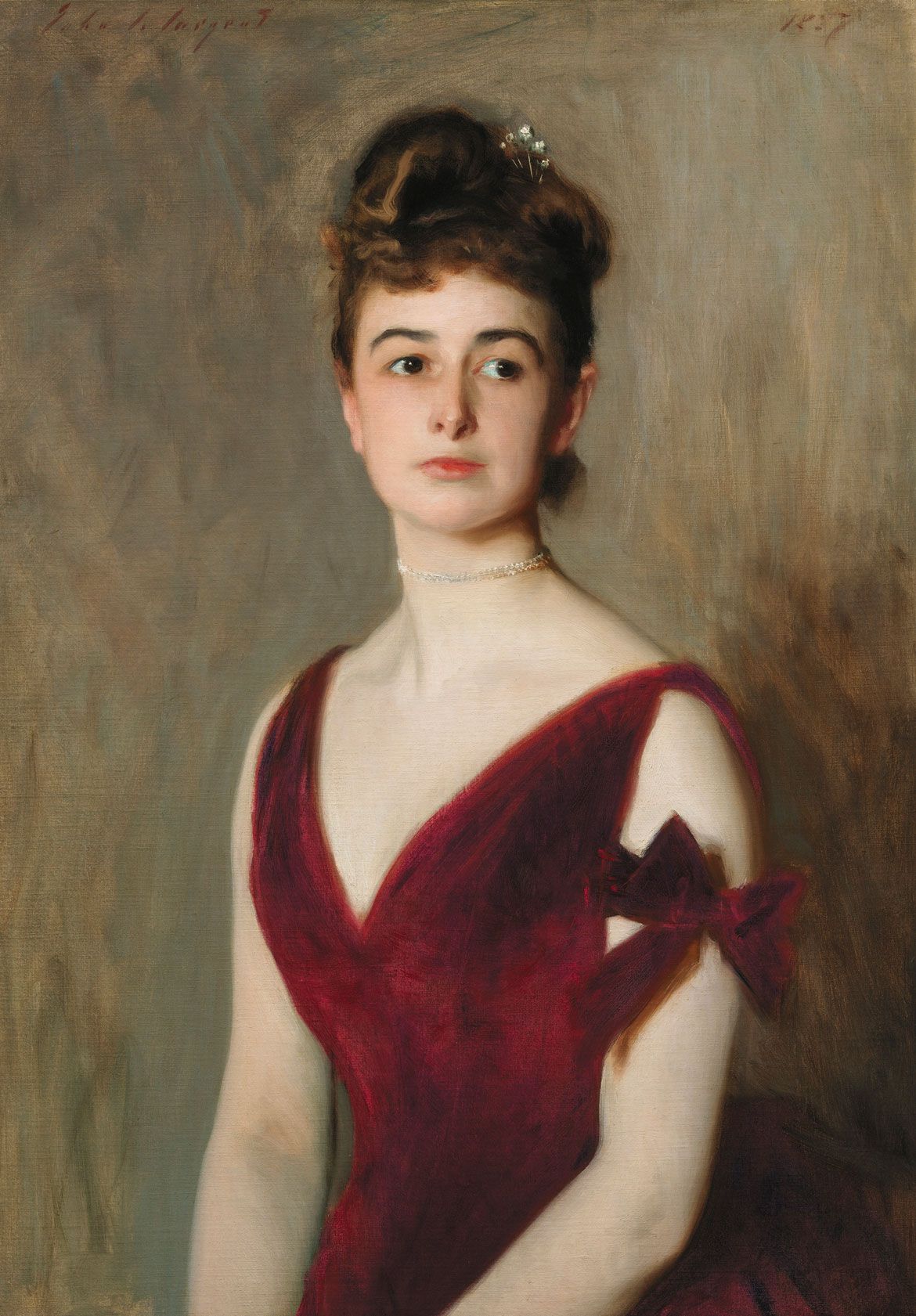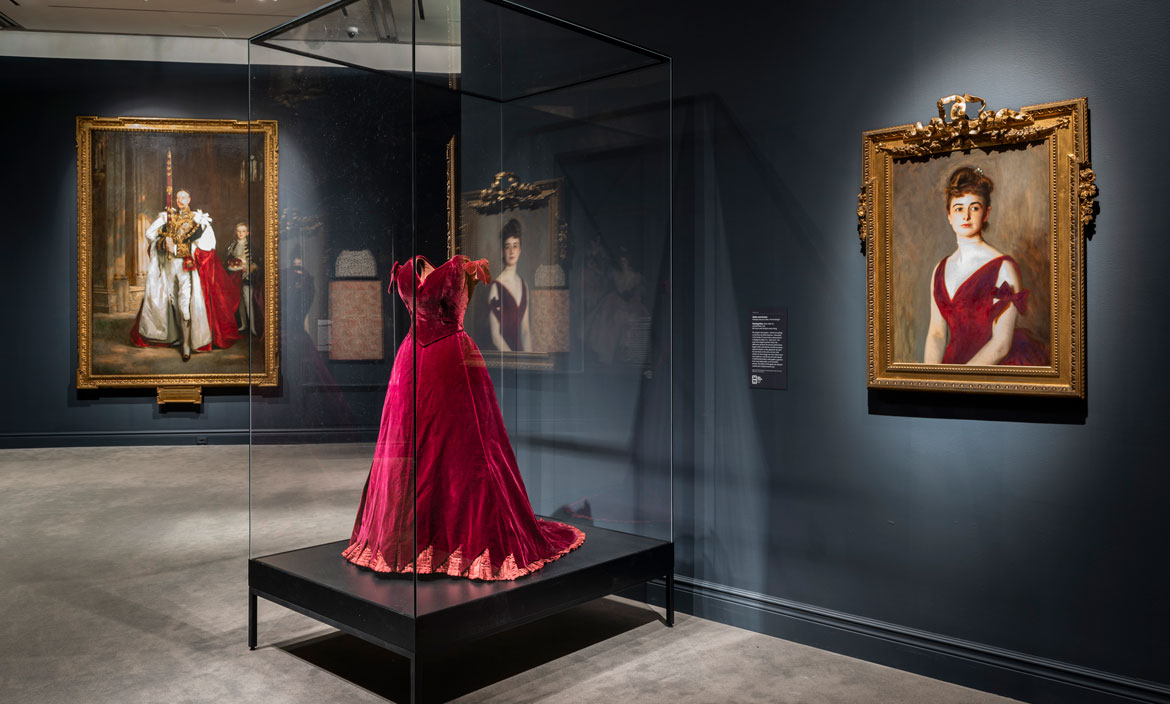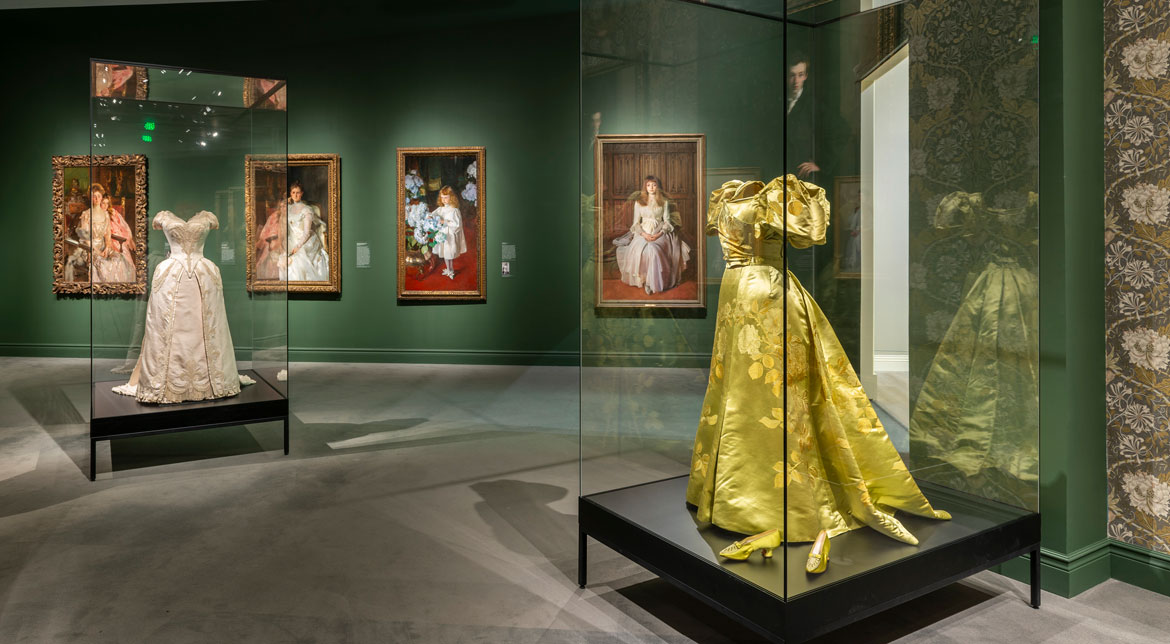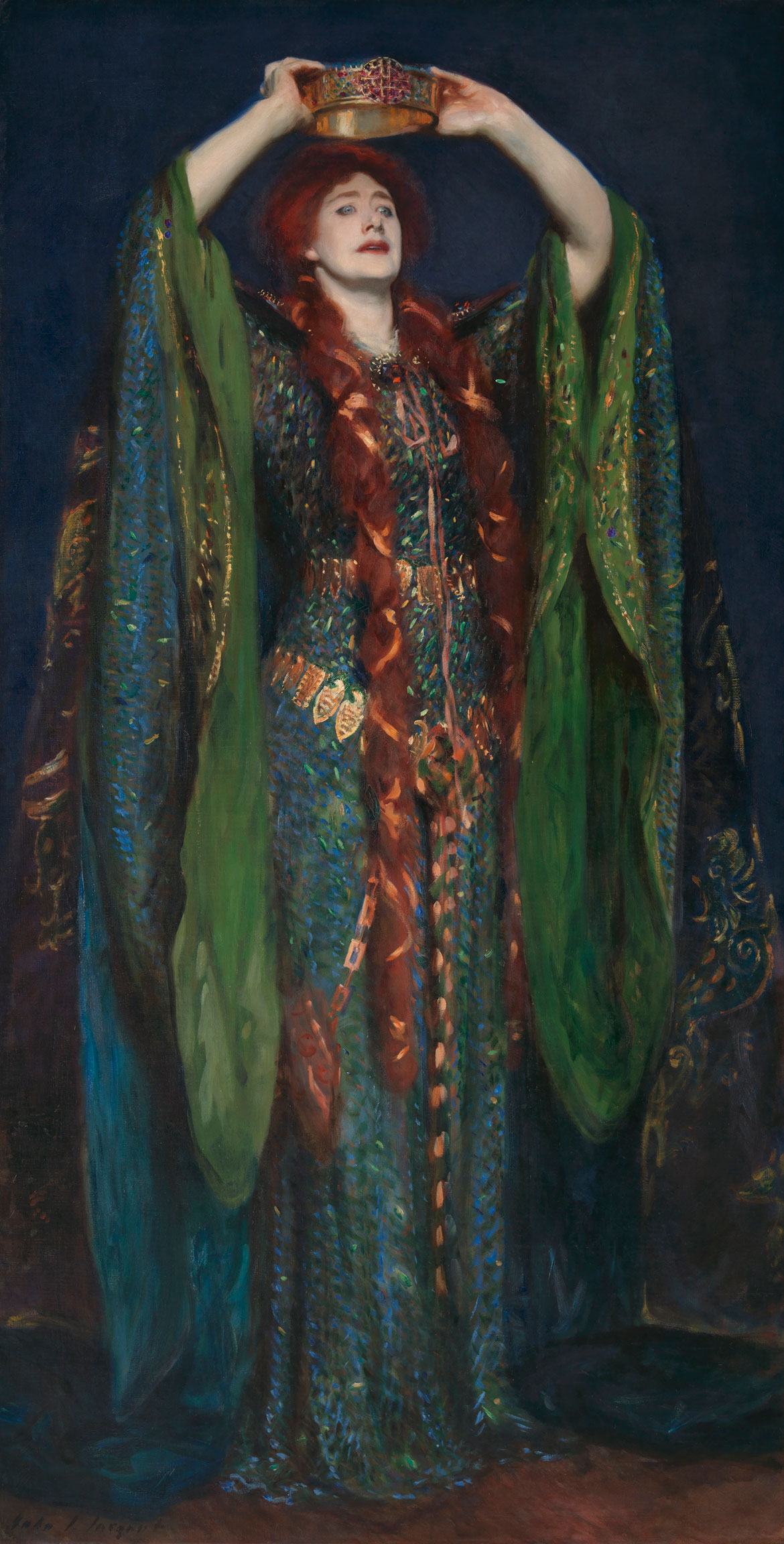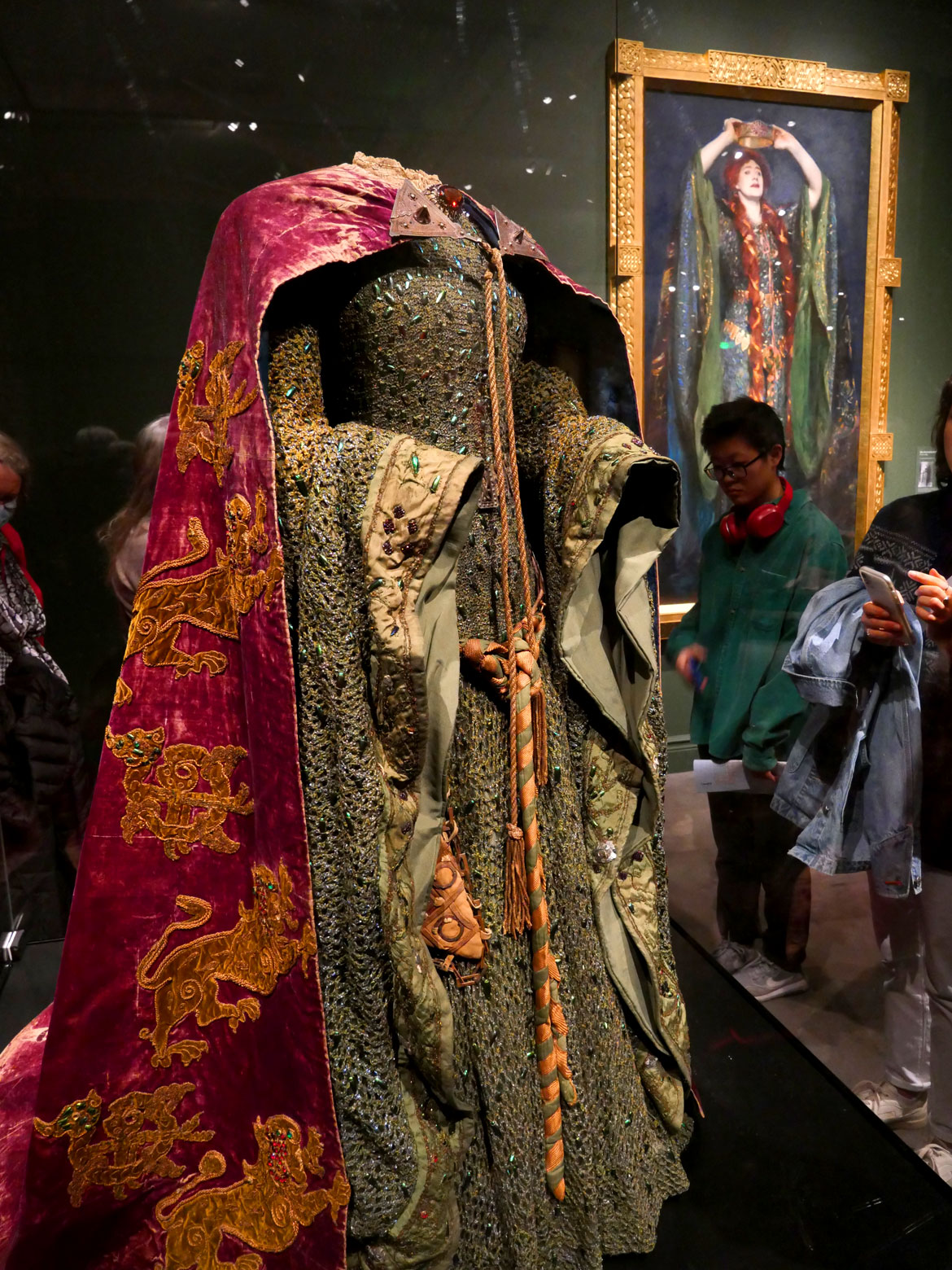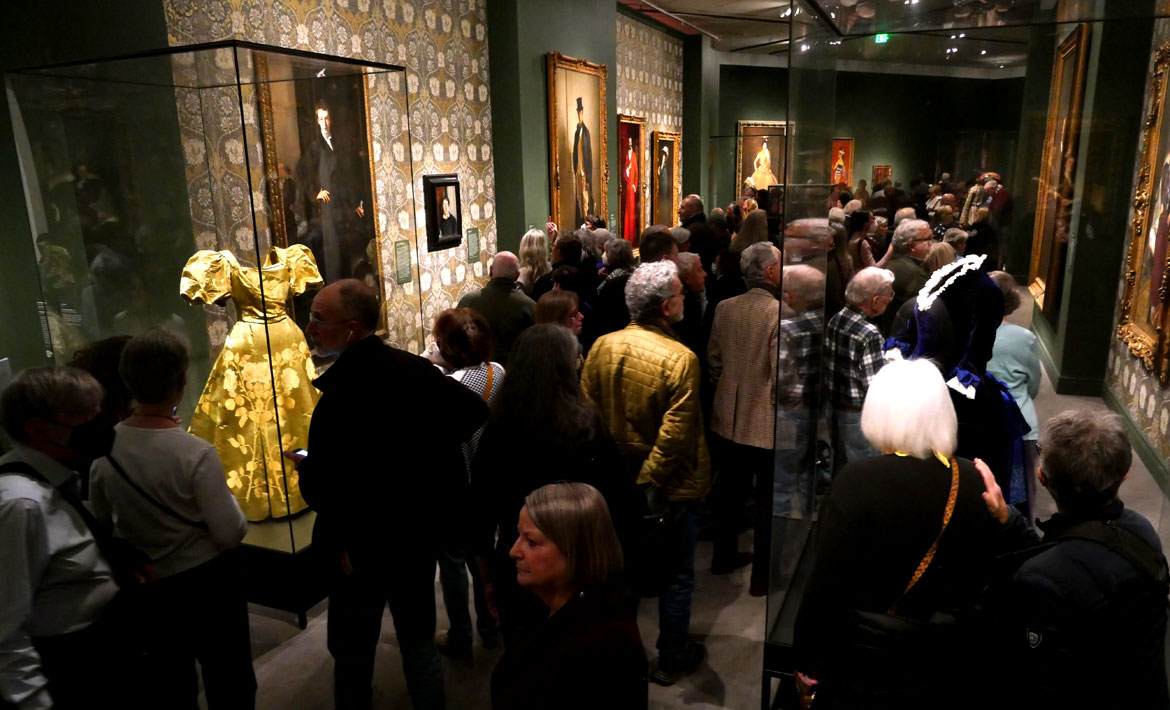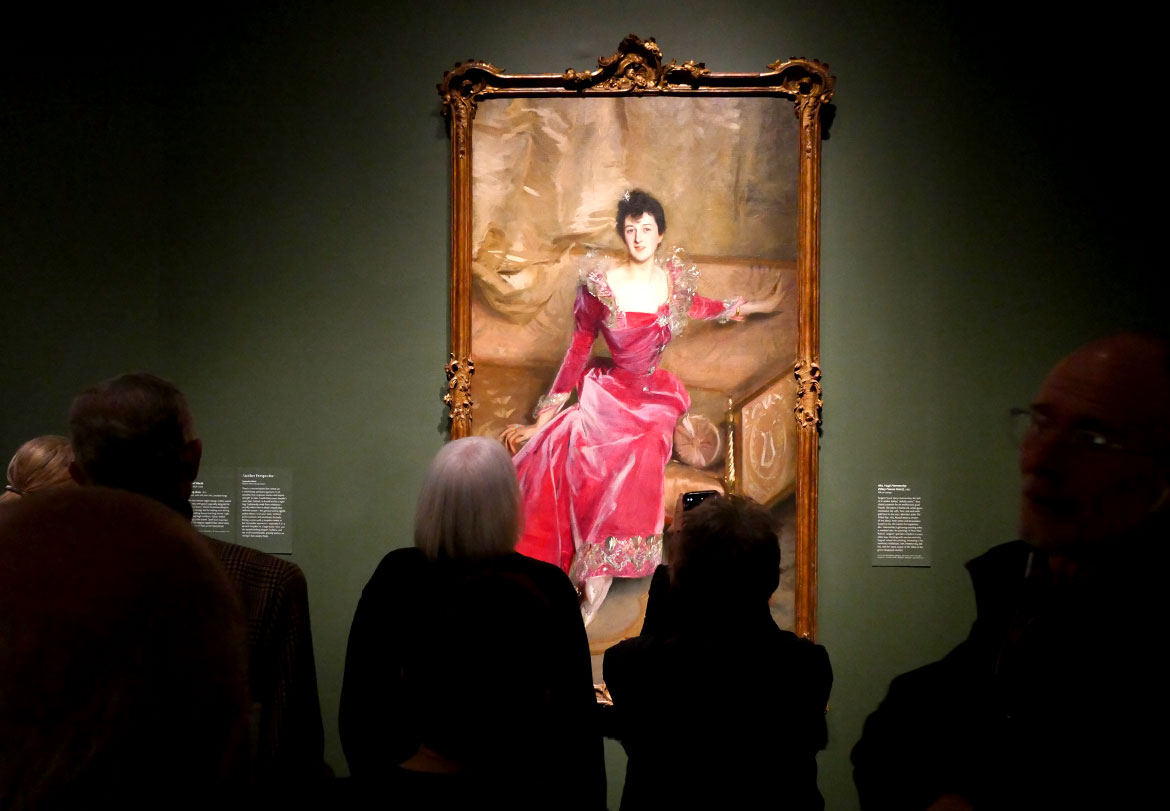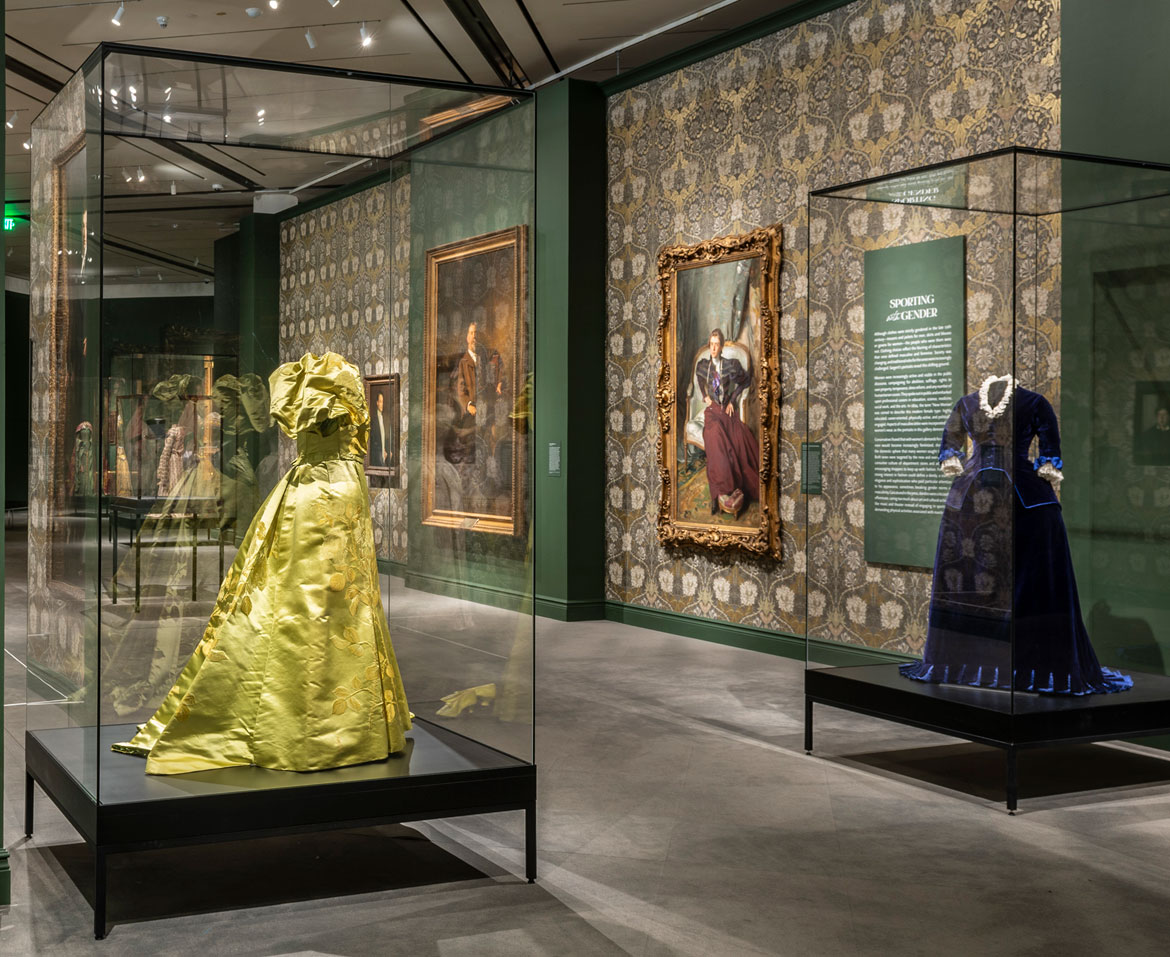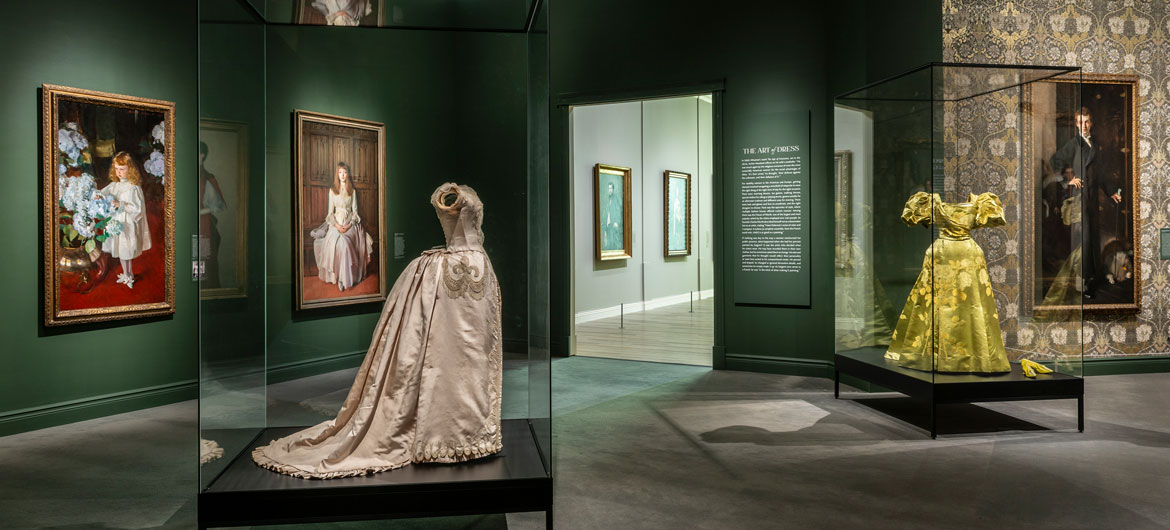The thrill of “Fashioned by Sargent” is 19th century society portrait painter John Singer Sargent’s dashing skill with a brush. I always think of him as an incredibly sure-handed marksman—each suave brushstroke always landing in exactly the right place.
“Fashioned by Sargent,” on view Boston’s Museum of Fine Arts from Oct. 8, 2023, to Jan. 15, 2024, aims to demonstrate the role attire played in the portraits of Sargent (1856–1925). Organized by Erica E. Hirshler, a curator at the museum, for the Boston museum and Tate Britain, the exhibition pairs some 50 paintings by Sargent with more than a dozen dresses and accessories “reunited for the first time with Sargent’s portraits of the sitters who once wore them.”
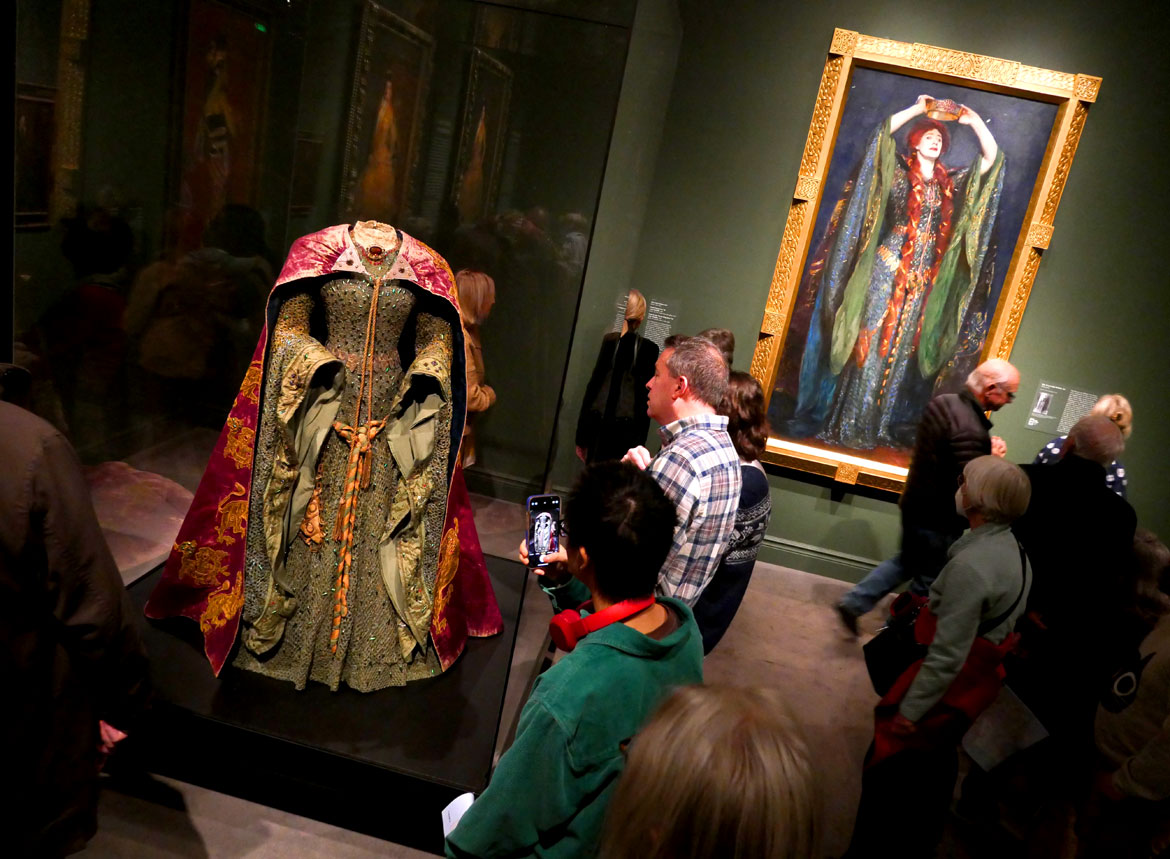
The most spectacular pairing here is Sargent’s 1889 painting of the red-haired “Ellen Terry as Lady Macbeth” in a royal blue and green gown laced with gold. She raises her arms to place the corrupt crown upon her own head. Sargent had seen Terry perform the role in a December 1888 production at London’s Lyceum Theatre, subsequently writing to Isabella Stewart Gardner that the actress “looks magnificent in it, but she has not yet made up her mind to let me paint her in one of the dresses until she is quite convinced she is a success.”
I’d only previously seen the painting in reproduction and it always stuck me as a melodramatic outlier in his body of dashing, but generally sober portraits. The crowning pose was reportedly not one Terry acted in the play. It’s as if Sargent was stretching to be as theatrical as the play. The painting becomes a showstopper when paired here with the original green “Beetle Wing Dress”and cloak designed by Alice Laura Comyns-Carr that Terry wore in the painting. It sparkles with crocheted green yarn and blue tinsel accented by the actual iridescent wings of jewel beetles.
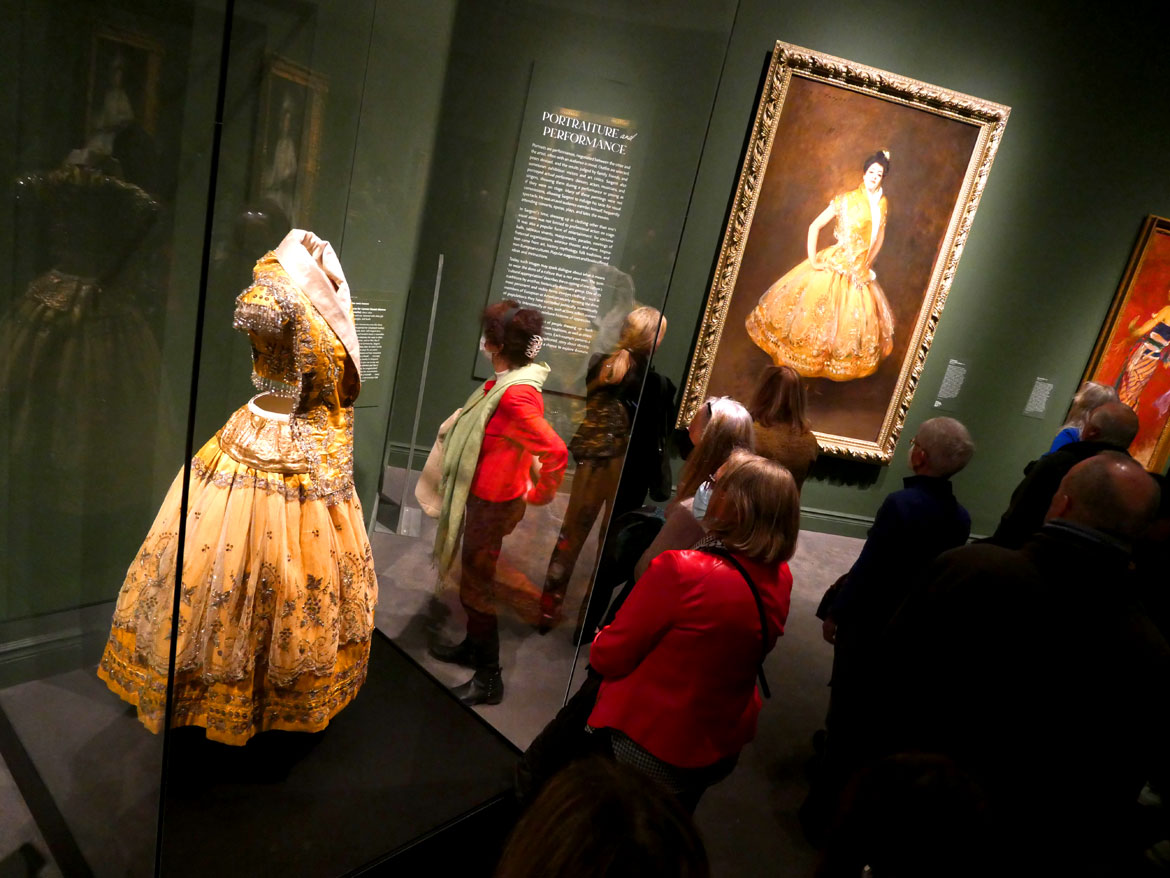
The exhibition also includes a gold silk satin skirt, “bolero” jacket and beaded shawl that 21-year-old Spanish music hall dancer Carmen Dauset Moreno, better known as La Carmencita, wore when Sargent painted her when she was on tour in New York around 1890. The show reunites Sargent’s 1922 portrait of his friend Countess of Rocksavage (Sybil Sassoon) and the lace-trimmed black silk velvet and satin gown that Sargent ordered from the House of Worth for her to wear in the painting. There’s a swatch of the red silk velvet gown that Mary Hammersley wore when Sargent painted her around 1890 and a kashmiri style shawl that Sargent used as a studio prop (which survived because Sargent gave it to Sassoon). The exhibition is filled out with clothing that evoke those Sargent painted though not the exact ones—a fan, a top hat, a Turkish robe, satin shoes.
“When we look at Sargent’s work in the context of fashion, we discover his power over his sitters,” exhibition organizers write. “He often told them what to wear, his choices revealing aspects of their personality, gender, or social position.” Sargent usually paints little of people’s surroundings, so clothes become a primary signifier of class, prestige, wealth, power.
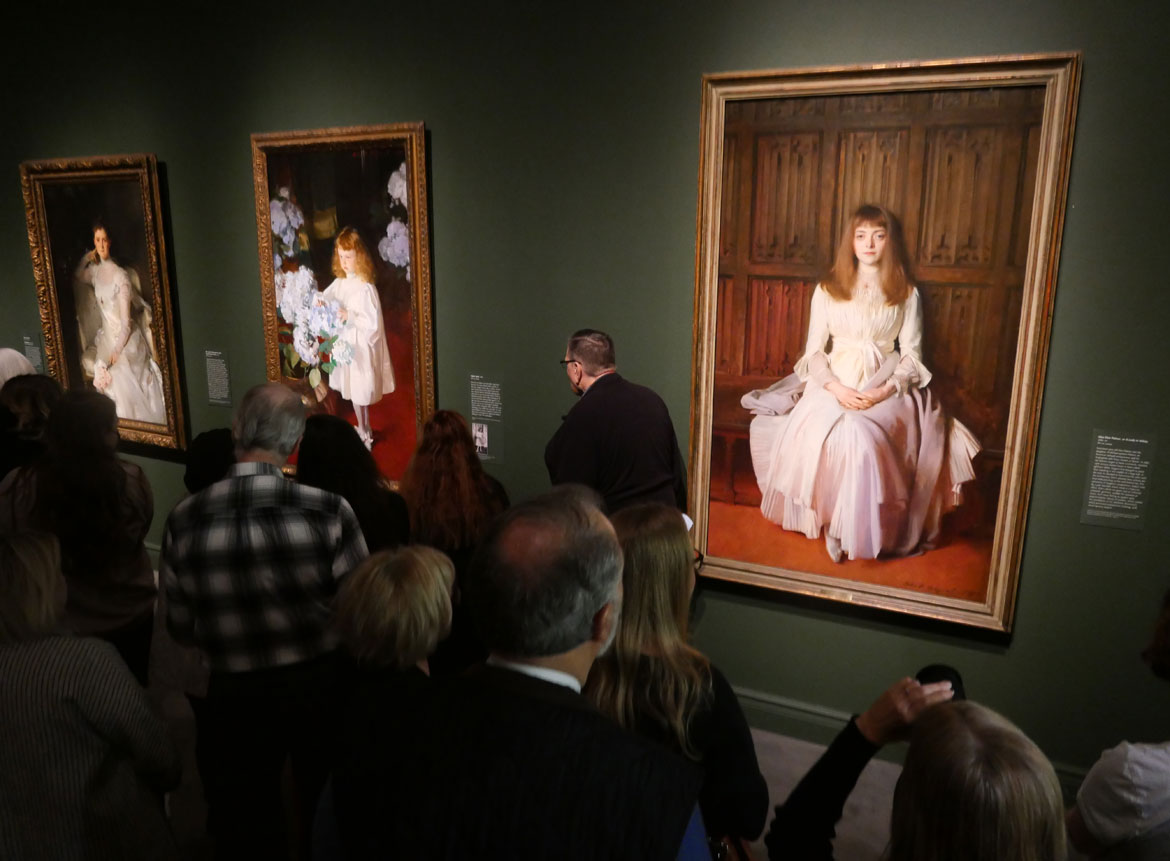
Sargent’s father was a doctor with roots in Gloucester, Massachusetts, and Philadelphia. His mother was an avid traveler. The painter was born in Florence, Italy, to his American parents, and came to speak English, Italian, French and German as they lived across Europe. He studied at Florence’s Accademia di Belle Arti, Paris’ Ecole des Beaux-Arts Paris, and in the independent atelier of Paris portrait painter Carolus-Duran, where he honed his realism.
Sargent was based in Paris from 1874 to 1886, and during that time traveled to paint in Greece, Italy and Spain. The sexiness of Sargent’s 1883-84 portrait of “Madame X (Madame Pierre Gautreau [Virginie Amélie Avegno])” prompted demands that it be removed when it was exhibited at Paris’ Salon in 1884. Sargent portrayed Gautreau, the American wife of a Paris banker, like the figurehead at the prow of a ship, dressed in a satin and velvet dress with bare arms and a plunging neckline. “In its original state with one diamond strap falling from her shoulder, the painting was ridiculed, described as indecent and a sensational, vulgar attempt to garner attention,” exhibition organizers write. “A fashion faux pas became a potent symbol of upstart Americans who threatened to topple long-standing national hierarchies of fashion, society, and identity.” The controversy was part of what prompted Sargent to contemplate leaving Paris.
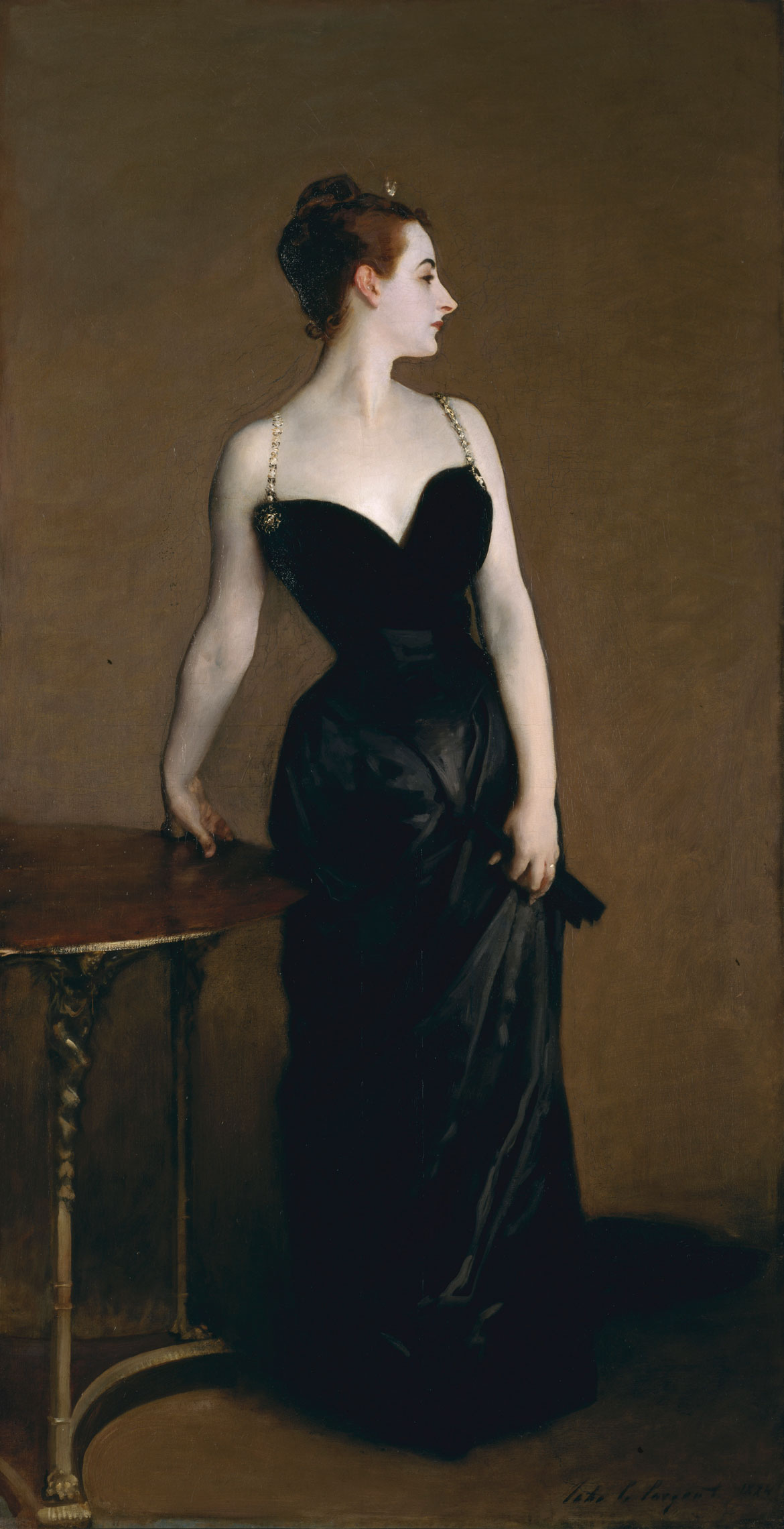
Sargent was friendly with the French Impressionist Claude Monet—and painted him at work, probably at Giverny, France, around 1885. After Sargent moved to London in 1886, he experimented with his own version of Impressionism in the English countryside. Sargent is too preternaturally skilled a painter to ever be mediocre, but it can feel as if a moody method actor has wandered into the middle of a frothy musical.
In London, “Sargent became the leading portrait painter of his generation, producing 900 oil paintings, 2,000 watercolors, and countless sketches,” the museum writes. His sirs and ladies and lords of the British empire at high ebb (before the world wars and the unwinding of the colonial states) and the rising American Gilded Age appear life-sized, spotlit in dark rooms, looming down on us.
This is epitomized here by Sargent’s depiction of the launch of Britain’s Edwardian age. Sargent had turned down an invitation to paint the coronation of Britain’s King Edward VII in 1902, but he reenacted it for his 1904 portrait of “Charles Stewart, Sixth Marquess of Londonderry, Carrying the Great Sword of State at the Coronation of Edward VII, August 1902, and Mr. W. C. Beaumont, His Page on That Occasion.”
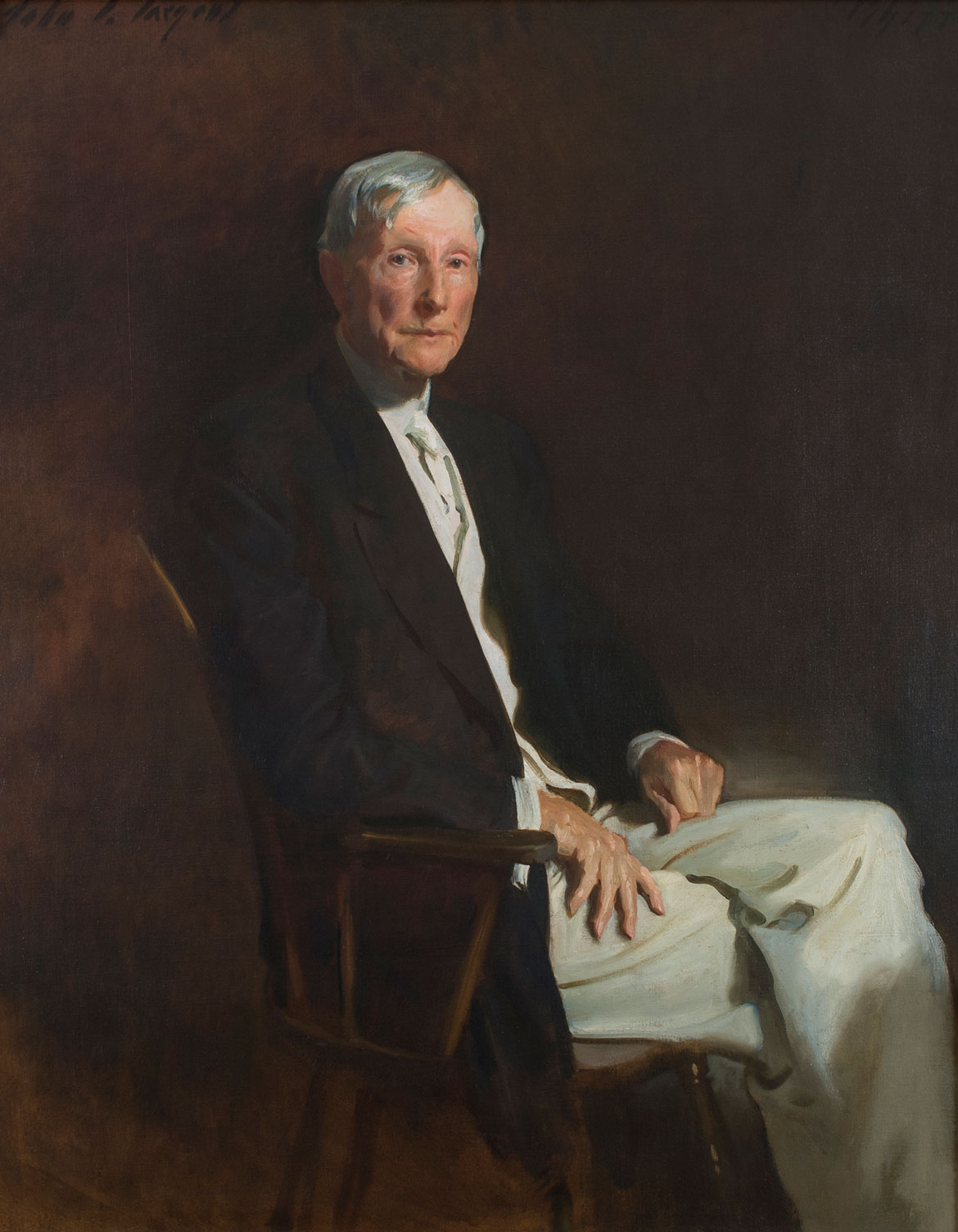
Then there’s his 1917 portrait of the silver-haired American oil oligarch John D. Rockefeller. Sargent had given up his portrait practice by then, but reluctantly agreed to the commission and donated his proceeds to the wartime British Red Cross. Sargent depicted Rockefeller dressed in a serge coat and tan pants, seated upon Windsor chair—in Sargent’s eyes, an “old Gentleman who looks like a mediaeval saint.” To me, it feels like Sargent is working to convince us that Rockefeller is a model of Yankee sobriety and restraint.
Sargent paints these lifestyles of the rich and famous with seemingly effortless panache—which has always made him both widely beloved and somewhat suspected of perhaps not being deep enough. He brings faces into sharp focus, but their outfits and surroundings have a softer-focus blur. This was a traditional approach to portraiture—and continues to be a primary approach of today’s society photographers. It gives Sargent room to let loose. Details like clothing that can feel sharp, upon closer inspection reveal themselves to be bravura daubs precisely placed to capture the drama of light.
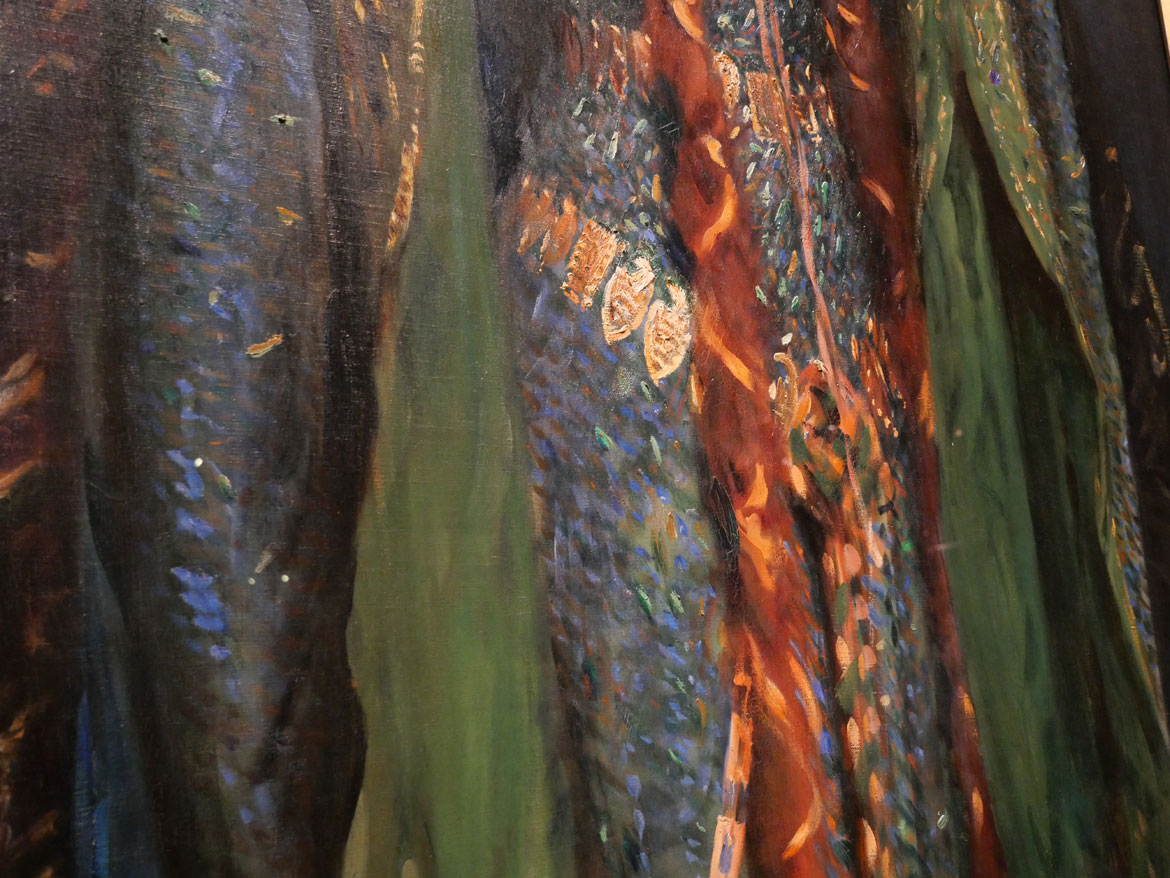
Near the end of the exhibition hangs Sargent’s 1892 portrait of “Lady Agnew of Lochnaw (Gertrude Vernon).” She was in her London home Recovering from severe influenza, which perhaps is partly responsible for the painting’s languid mood. She wears a white silk confection with sheer organza sleeves and a lilac sash, as she leans into the side of the chair, with her arm dangling casually over the side. There’s something in the tension between the formal gown and her casual posture. Her blue-green eyes watch us with a serious, knowing gaze. Her red lips bend into maybe the faint beginning of a smile.

If this is the kind of coverage of arts, cultures and activisms you appreciate, please support Wonderland by contributing to Wonderland on Patreon. And sign up for our free, occasional newsletter so that you don’t miss any of our reporting. (All content ©Greg Cook 2024 or the respective creators.)
